Physical Address
304 North Cardinal St.
Dorchester Center, MA 02124
The first descriptions of spine disorders were recorded nearly 4000 years ago in Egypt, when patients with such afflictions were left bedridden and death was considered unavoidable. One of the first extensive series on surgery of the spine was reported by Elsberg in 1925, in which the surgical treatment of spinal cord tumors was described. Since those early reports, spine surgery has made remarkable advancements, particularly since the 1980s. As surgical techniques have matured, complex operations are being performed on spine diseases once thought incurable. Moreover, increasingly older patients with multiple comorbidities are presenting for spine procedures. Consequently, the anesthetic approach to patients scheduled for spine surgery must consider the following issues: a basic knowledge of spine anatomy and imaging modalities; an awareness of the specific spine disorder being treated and the surgical procedure planned; preoperative risk assessment and optimization; potential airway difficulties; patient positioning; anesthetic choices; intraoperative medical decision-making (blood replacement, blood salvage, hemodynamic goals, pulmonary function); postoperative airway concerns; and perioperative pain management. This chapter discusses these issues.
The anatomy of the spine can be divided into that pertaining to the vertebral bony column and the contents of the vertebral canal.
The vertebral column is composed of 33 vertebrae. In adult life this number is functionally reduced to 24 presacral vertebrae, the sacrum, and the coccyx. The presacral vertebrae consist of seven cervical, 12 thoracic, and five lumbar bones. The five sacral and four coccygeal vertebrae fuse early in development. The vertebral column normally exhibits four curves in the anteroposterior (AP) plane. The two forward curves, or lordoses, are in the cervical and lumbar areas, and the two posterior curves, or kyphoses, are in the thoracic and sacral areas. The combination of these curves gives the normal bony spine the characteristic S shape when viewed from the side ( Fig. 21.1 ).
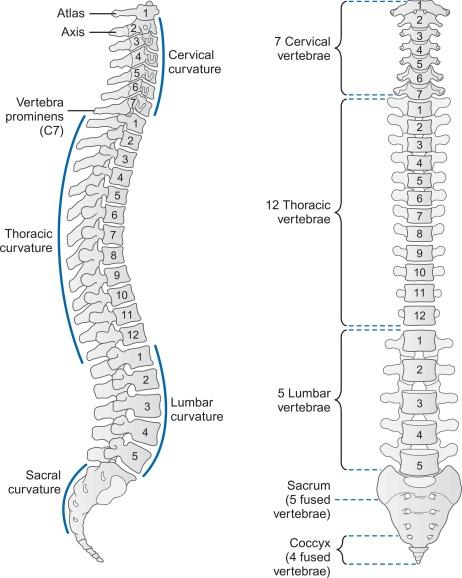
Each of the individual “standard” vertebrae that make up the vertebral column is a single bony structure consisting of a large body, bilateral pedicles, bilateral lamina, bilateral transverse processes, a spinous process, and four articular processes ( Fig. 21.2 ). The two pedicles laterally, the two lamina posteriorly, and the body anteriorly together form the vertebral canal, in which lies the spinal cord. The segmental nerves exit between the vertebrae through the intervertebral foramina. The four articular processes mate with corresponding processes on the vertebrae above and below to form the facet joints. The facet joint articulations provide posterior stability, and the body articulations provide anterior and vertical stability. In addition, the facet joints provide flexion, extension, and lateral rotation of the spine.
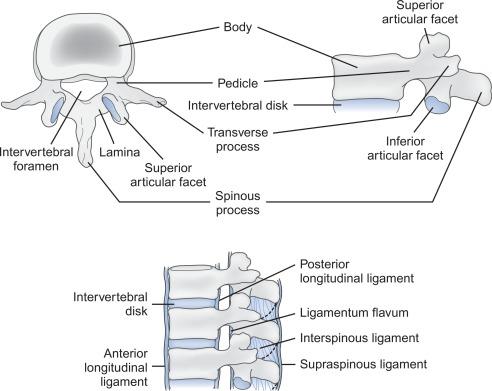
The first two cervical vertebrae, C1 and C2, differ in structure from the standard vertebrae ( Fig. 21.3 ). C1, the atlas, is ring-shaped and wider than the other vertebrae. The superior articular surfaces are configured to articulate with the two occipital condyles located at the base of the skull on either side of the foramen magnum. The atlas is composed of anterior and posterior arches, each possessing a tubercle while sharing lateral masses. The atlas has no spinous processes or body. C2, the axis, possesses a body that projects superiorly as the dens (odontoid process) (see Fig. 21.3 ), and a short bifid spinous process. The axis has two large flat superior articular facets. The transverse ligament of the atlas holds the dens in place, preventing horizontal movement of the atlas.
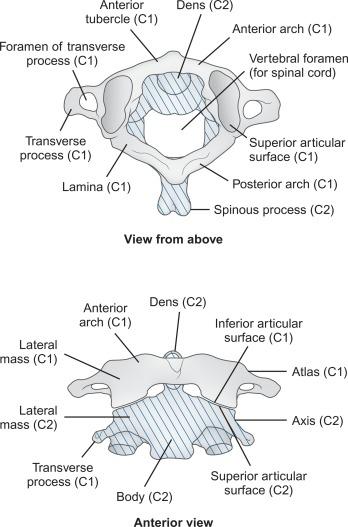
The anterior longitudinal ligament and the posterior longitudinal ligament (see Fig. 21.2 ) extend from the base of the skull and atlas to the sacrum. The anterior ligament is attached to the anterior surface of the vertebrae and intervertebral disks. The posterior ligament is attached to the posterior surface of the vertebrae and the intervertebral disks and lies within the vertebral canal. These two ligaments provide extension and flexion stability to the vertebral column. The supraspinal and interspinal ligaments join the spinous processes at each level, providing additional flexion stability. The ligamentum flavum unites the vertebral laminae at each level and forms part of the posterior border of the intervertebral foramen.
The intervertebral disks are fibrocartilaginous joints composed of an interior nucleus pulposus surrounded and enclosed by a tough anulus fibrosus ( Fig. 21.4 ). Together, these two components provide a strong attachment between adjacent vertebrae but allow some movement. In addition, the disks act as very efficient shock absorbers.
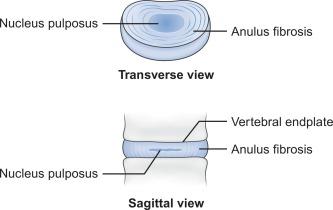
The facet joints are synovial joints, which are paired and compose part of the posterior elements of the vertebral column. With the intervertebral disks they form the remaining articulations of the vertebrae with each other. As posterior elements, the facet joints allow flexion of the spine. The facet joints of the cervical region are less rigid, thus allowing greater flexion of the neck.
The spinal cord is contained within the confines of the vertebral canal. The anteroposterior (AP) diameter of the cervical cord constitutes about 40% of the diameter of the cervical canal, decreasing in diameter with neck extension. The spinal cord is contiguous with the brainstem at the foramen magnum, and in the adult it extends to the conus medullaris at about the level of the first or second lumbar vertebra. The filum terminale attaches the end of the conus to the first coccygeal segment of the bony spine. The cord exhibits two prominent bulges in the cervical and lumbar areas, which correspond to the origins of the nerves to the upper and lower extremities, respectively. A cross section of the cord reveals a mixture of white matter and gray matter ( Fig. 21.5 ). The gray matter, in the shape of an H, surrounds the central canal and contains the cell bodies of the spinal neurons.
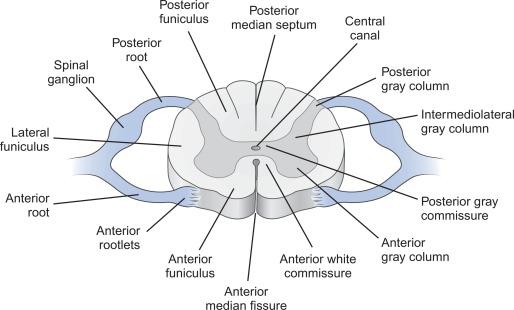
The dorsal horns are associated with sensory functions, including pain, position sense, touch, and temperature. The ventral horns contain neurons associated with motor functions and spinal reflexes. The surrounding white matter contains the myelinated and unmyelinated fibers that communicate with higher and lower centers, including the brainstem and cerebral cortex. The descending motor pathways travel in the white matter located in the lateral and ventral areas of the cord. The corticospinal tract conducts all primary motor impulses. The vestibulospinal and rubrospinal tracts also participate in motor function and are located in the ventral and lateral areas of white matter, respectively. The dorsal areas of white matter contain the dorsal column tracts, the spinothalamic tracts, and the spinoreticular tracts, among others. These pathways transmit sensory information to higher cord segments and the brain.
The sympathetic nervous system is also segmental and traverses the length of the vertebral column in two chains anterior to the bony spine ( Fig. 21.6 ). Segmental communication is accomplished at each spinal segment via the communicating ramus of each segmental spinal nerve. The segmental spinal nerves are made up of the confluence of a dorsal root and a ventral root at each level (see Fig. 21.6 ).
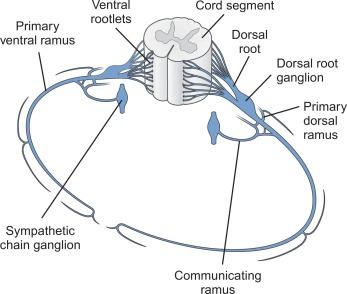
A nerve emerges from each side of the spinal cord; thus they are paired. The dorsal roots conduct sensory information, including pain. All nerve cell bodies of afferent axons are located in the dorsal root ganglion. The ventral roots conduct primarily motor and efferent information from the cord to the periphery. The two roots combine in the spinal nerve as they traverse the vertebral foramen. The nerve then divides into three rami: dorsal, ventral, and communicating. The ventral ramus continues as the primary spinal nerve, the dorsal ramus innervates the paraspinous muscles of the back and the facet joints at each level, and the communicating ramus provides segmental neuronal connections to the sympathetic chains.
The spinal nerves have a particular relationship to the respective spinal vertebrae ( Fig. 21.7 ). The spinal nerves exit the vertebral canal via the intervertebral foramina. These foramina are formed by the juxtaposition of adjoining vertebrae in the spinal column.
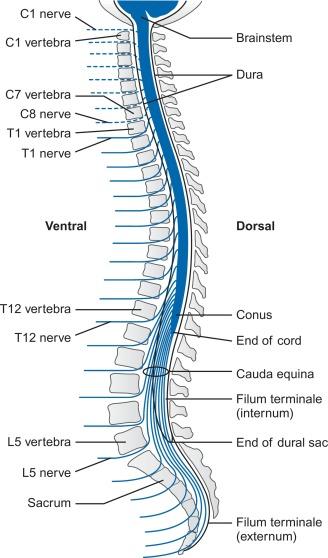
The spinal cord is supplied with blood from the aorta via the vertebral and segmental or radicular arteries; the three main arteries of the spinal cord are the single anterior spinal artery in the anterior or ventral median sulcus and two posterior spinal arteries located in the area of the dorsal nerve rootlets ( Fig. 21.8 ). These three arteries usually arise as branches of the vertebral arteries at the base of the brainstem and traverse the entire length of the cord ( Fig. 21.9 ). The blood flow is augmented by multiple segmental radicular and medullary arteries that enter at the intervertebral foramen (see. Figs. 21.8 and 21.9 ).
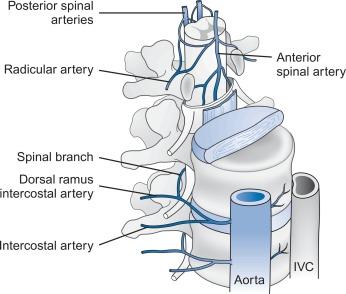
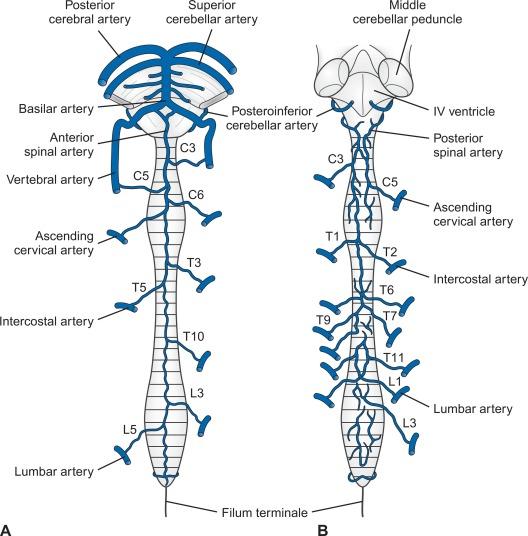
The anterior spinal artery supplies the anterior two-thirds of the cord, and the posterior spinal arteries supply the posterior one-third. Below the level of the cervical cord segments, additional blood supply is provided by segmental or radicular arteries that arise as branches of the aorta and enter the cord arterial system. The most consistent of these arteries is the artery of Adamkiewicz, which is the largest segmental feeder in the thoracolumbar region of the cord. It usually enters as a single vessel between the ninth and the eleventh thoracic levels and arises on the left side of the aorta. The artery of Adamkiewicz is thought to be the principal contributor to the arterial supply of the entire thoracic and lumbar cord distal to its entry. Loss of this artery after surgery or trauma to the aorta may produce paraplegia in the thoracic region.
The arterial network of the three main blood vessels supplies blood to the interior of the cord through an extensive network of arterioles and capillaries. The density of the capillary bed reflects the metabolic demands of the different areas of the cord. Blood flow through these capillaries is very sensitive to compression of the cord, and ischemia may result.
Venous drainage of the spinal cord is through radial veins serving the parenchyma. The veins feed into the coronal venous plexus or longitudinal veins on the surface of the cord, which are, in turn, drained by medullary veins that penetrate the dura adjacent to the dural penetration of the nerve roots to join the epidural venous plexus. The epidural or internal vertebral venous system drains into the external vertebral venous system, which communicates with the caval veins. The veins in the epidural system are valveless and, therefore, subject to engorgement in certain normal and disease states, such as pregnancy and obesity, in which there is an increase in the intra-abdominal pressure or obstruction to venous flow through the inferior vena cava.
Spinal cord blood flow (SCBF) has been studied extensively in animal models. The values and data obtained from these studies are consistent with values obtained for the brain; average SCBF is about 60 mL/100 g/min, including a threefold to fourfold gray matter–white matter differential in blood flow. Autoregulation in the cord mimics that in the brain, with flow well maintained between a mean arterial blood pressure (MAP) of 60 to 120 mm Hg. Likewise, the effects of arterial blood gas tensions are similar to those in the brain; hypoxemia and hypercapnia cause vasodilation, and hypocapnia causes vasoconstriction ( Fig. 21.10 ).
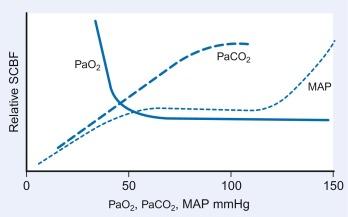
Injury to the spinal cord disturbs autoregulation of blood flow. Trauma to the cord results in a decrease in SCBF and loss of autoregulatory function. The nature of the operative procedure itself may also have an effect on SCBF. This effect is well recognized with spinal distraction and instrumentation but may also occur during other operations, such as simple laminectomy.
Imaging of the spine and spinal cord is an essential part of the diagnosis and treatment of spinal diseases. A variety of imaging modalities are available for the assessment of spinal pathology, the most common of which are plain radiography, computed tomography (CT), CT angiography, magnetic resonance imaging (MRI), MR angiography, bone scanning, single-photon emission computed tomography (SPECT), and positron emission tomography (PET). The choice of imaging modalities best suited for the patient depends on the history, physical findings, and differential diagnosis. A general review of the common imaging techniques used in spine disease can be found in the later section on traumatic spinal cord injury (SCI).
Degenerative disease of the cervical spine affects more than 90% of individuals older than 65 years. The term cervical spondylosis refers to the nonspecific degenerative process of the spine that may result in degenerative listhesis, spinal stenosis, as well as neural foraminal encroachment ( Fig. 21.11 ).
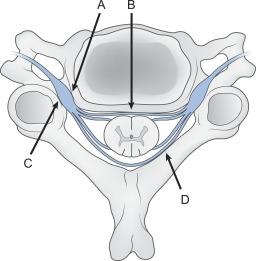
In those individuals who eventually experience symptoms of cervical degenerative disease, radiculopathy is the most common. Cervical radiculopathy is defined as a neurologic condition characterized by dysfunction of a cervical spinal nerve, the nerve roots, or both. It is most commonly caused by lateral disk herniation, osteophyte overgrowth with narrowing of the lateral foramen (termed the lateral recess syndrome ), or cervical spinal instability caused by subluxation of a cervical vertebra ( Fig. 21.12 ).

MRI is the imaging modality of choice in the diagnosis of cervical radiculopathy; however, MRI is not indicated in the initial stages of management because the findings will not alter treatment. In general, medical management is attempted for 4–6 weeks, and if the patient remains symptomatic, an MRI study is appropriate. CT is of value primarily for defining the bony anatomy and for helping to distinguish whether the stenosis is due to soft or calcified lesions. Surgical treatment for cervical radiculopathy is indicated for severe clinical symptoms that medical therapy has failed to control combined with a compatible MRI study demonstrating nerve compression; for the persistence of pain despite medical management for at least 6 weeks; and for the presence of an evolving neurologic deficit.
Cervical spondylotic myelopathy (CSM) is the most common type of spinal cord dysfunction in patients older than 55 years. Originally described more than 50 years ago, CSM is the result of narrowing of the cervical spinal canal due to a degenerative process or a congenital disorder. The primary pathophysiologic abnormality in CSM is a reduction in the sagittal diameter of spinal canal, with cervical myelopathy developing in nearly all patients in whom there is a greater than 30% reduction in the cross-sectional area of the cervical vertebral canal. Typical signs and symptoms of CSM are pain in the neck, shoulder, and subscapular areas; numbness or tingling in the upper extremities; motor weakness in the upper or lower extremities; sensory changes in the lower extremities; gait disturbances; bowel and bladder dysfunction; and spasticity, hyperreflexia, and clonus typical of an upper motor neuron lesion. The most common presentation of CSM is a spastic gait. Physical findings include atrophy of the muscles of the hand, hyperreflexia, electric-shock-like sensations down the arm or back after flexion of the neck (Lhermitte’s sign), and sensory loss. Plain films often show evidence of osteophyte formation, kyphosis, and subluxation. MRI remains the imaging modality of choice, providing information about the spinal canal (demyelination, spinal cord atrophy, and edema), intervertebral disks, vertebral osteophytes, and ligaments. Treatment of CSM initially involves nonoperative therapy; however, early surgery is associated with significant improvement in the neurologic prognosis. If surgical intervention is chosen, treatment considerations include anterior cervical discectomy and fusion (ACD&F), anterior cervical fusion (ACF), cervical laminoplasty, and posterior cervical decompression and fusion.
The anesthetic management of patients with cervical spine instability or myelopathy should consider the specific technique most appropriate for securing the airway, choice of anesthetic agents, hemodynamic monitoring needs, use of vasoactive medications, and positioning. For patients with symptomatic spinal stenosis, an awake fiberoptic intubation is often suggested; however, initial induction of anesthesia followed by fiberoptic intubation utilizing manual in-line stabilization with/without spinal cord monitoring is a viable option. The use of invasive (or advanced noninvasive) blood pressure monitoring is advocated to facilitate maintenance of an adequate spinal cord perfusion pressure (i.e., mean artery pressure ≥ 85 mm Hg) throughout the case. If electrophysiologic (EP) spinal cord monitoring is planned, the anesthetic strategy should select agents with minimal effects on the EP waveform potentials. The decision to extubate the patient following surgery should be made only in the absence of airway edema, neck hematoma, and depressed mental status.
Intervertebral disks are composed of a well-hydrated central nucleus pulposus surrounded by an outer anulus fibrosus. With age, the disks deteriorate, ultimately resulting in herniation when the anulus fibrosus breaks open or cracks, allowing the nucleus pulposus to extrude (see Fig. 21.12 ).
In the cervical spine, the most common location of the herniation is at C5–C6, followed by C6–C7, and herniation is most common in individuals older than 40 years. The symptoms of a cervical disk herniation are neck pain and radicular symptoms, which consist of shoulder, arm, or hand paresthesias or pain, and muscle weakness in a dermatomal nerve root distribution. Patients may also present with symptoms of a cervical myelopathy if the herniation is centrally located. In patients in whom a disk herniation is suspected, plain films may demonstrate a narrowed disk space, osteophytes, or subluxation of the vertebra. An MRI study is the radiologic imaging modality of choice for evaluation of a suspected herniated cervical disk ( Fig. 21.13 ).
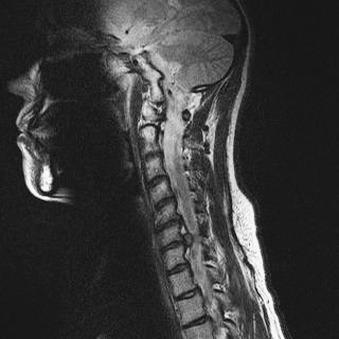
The primary treatment of a cervical disk herniation is medical management, at least initially. Cervical soft collars, anti-inflammatory agents, oral steroids, and physical therapy are all appropriate in the short term because more than 90% of patients with radiculopathic symptoms experience improvement with these measures. If nonsurgical therapy fails or the patient demonstrates progressive neurologic symptoms, surgical therapy is selected, typically an anterior cervical diskectomy and fusion (ACD&F), with or without anterior cervical plating.
Complications of surgery include thoracic duct injury, cerebrospinal fluid (CSF) leak, spinal cord or nerve root injury, vertebral artery injury, perforation of the esophagus or trachea, recurrent laryngeal nerve injury (vocal cord paralysis), postoperative hematoma, and wound infection. In instances in which there is a significant postoperative hematoma, the airway should be left secured until the patient is fully awake, the hematoma is not enlarging, and there is a tracheal cuff leak.
Syringohydromyelia refers to the cystic cavitation of the spinal cord. Two main forms have been described: syringomyelia and hydromyelia. In hydromyelia, there is primary dilatation of the central canal that is often associated with abnormalities at the foramen magnum such as tonsillar herniation (Chiari malformation) and basal arachnoiditis. In true syringomyelia, a cyst arises within the cord substance itself and does not communicate with the central canal or subarachnoid space. Common causes of true syringomyelia include trauma (most common), neoplasm, and arachnoiditis. In the typical presentation, an adult between the ages of 20 and 50 years complains of sensory loss (similar to central cord syndrome) in a “cape” distribution, cervical or occipital pain, wasting in the hands, and painless arthropathies. MRI is the investigation of choice and should include images of the cervical and thoracic spinal cord as well as the brain. Treatment focuses upon reestablishing normal CSF flow across the site of the injury. Therapeutic choices include a posterior fossa decompression and C1 laminectomy (with or without expansile duroplasty) in the presence of a Chiari malformation, fenestration of associated arachnoidal cysts, resection of an associated neoplasm, or placement of a shunt with direct drainage of the cyst into the subarachnoid space or pleural cavity. The airway management of patients with syringomyelia should consider the neurologic deficits commonly associated with this disease. In patients in whom syringomyelia is associated with the Chiari malformation, limitation of neck flexion and extension is vital in preventing further compression of neuronal structures. The limitation of neck motion during intubation by the use of fiberoptic bronchoscopy (either awake or after induction) is an appropriate choice.
Symptomatic thoracic disk herniations are rare, with an annual incidence of 1 per 1 million patients. Thoracic disk herniations occur most commonly at T8–T12, with a peak incidence between the ages of 40 and 60 years (mean, 46 years). The majority of disk herniations are located centrolaterally (94%) or laterally (6%) and manifest a variety of symptoms and signs, including pain (localized, axial, or radicular), myelopathy, sensory disturbances, and bladder dysfunction. The radiographic diagnosis is made through a combination of CT and MRI imaging. The majority of symptomatic thoracic disk herniations are effectively managed with nonoperative therapy alone. Indications for surgery include failure of a 4– 6-week trial of medical treatment; severe, persistent radicular pain; and significant neurologic deficits, particularly if there is any progression of symptoms. Thoracic spine operations are typically lengthy procedures (≥ 3 hours), often with clinically significant blood loss. Major surgical complications are uncommon; they include death from cardiopulmonary compromise, spinal instability requiring further surgery, and worsening of neurologic deficits.
Unlike a thoracic disk herniation, a lumbar disk herniation is very common, occurring in 2% of the general population at some time in their lives. Sciatica, resulting from a herniated lumbar disk, is the most common cause of radicular leg pain in the adult working population. Fortunately, the symptoms of sciatica typically resolve within 2 months from the onset in patients who are treated medically, and surgery is rarely necessary. The majority of lumbar herniations occur at the L4–L5 or L5–S1 spinal levels, most often posterolaterally, where the posterior longitudinal ligament is thinnest. The symptoms of a lumbar disk herniation range from lower back pain to radiculopathy with leg pain, weakness, and paresthesias. With a large centrally located disk herniation, the cauda equina syndrome may occur, resulting in lower back pain, bilateral lower extremity sensorimotor deficits, bladder dysfunction, sexual dysfunction, and perirectal sensory loss. The presence of cauda equina syndrome warrants urgent medical attention. MRI is the imaging modality of choice for suspected herniation of an intervertebral disk, as it clearly defines the local anatomy ( Fig. 21.14 ).
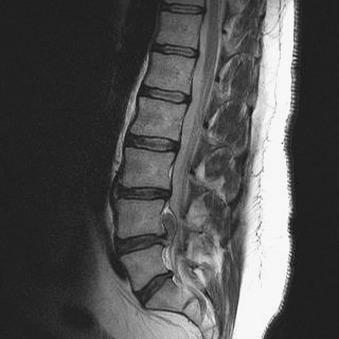
The majority of patients with lumbar disk herniations are treated medically. With such treatments, more than 75% of patients recover within 6–8 weeks. Accepted indications for surgical therapy include the cauda equina syndrome; significant motor deficits; severe pain unresponsive to medical therapy; failure of conservative therapy after 2–3 months; and large extruded disk fragments. Surgical options include diskectomy only, diskectomy with spinal fusion, hemilaminotomy, and/or laminectomy. Anesthetic management should consider the presence of presurgical neurologic deficits, the requirement for a meticulous positioning technique, identification of comorbidities that may increase the risk of complications, and the amount of anticipated blood loss. Invasive blood pressure monitoring is appropriate in those patients with serious comorbidities; however, noninvasive blood pressure monitoring is usually adequate in otherwise healthy patients scheduled for a lumbar procedure for disk herniation.
Lumbar spondylosis is a general term referring to changes in the vertebral joint characterized by progressive degeneration of the intervertebral disk, with subsequent changes in the bones and soft tissues. Disk degeneration, ligamentous and facet hypertrophy, spinal stenosis, and spondylolisthesis are the characteristic pathologic changes that result. The clinical spectrum of spondylosis includes spinal instability, spinal stenosis, and degenerative spondylolisthesis. Spinal stenosis, the most common of the spondylitic disorders, is a common indication for spinal surgery in adults older than 65 years.
The etiology of lumbar spinal stenosis may be congenital, acquired, or a combination of both. The patient with congenitally short pedicles typically has a shallow spinal canal that predisposes to spinal stenosis later in life as the typical degenerative changes in the spine occur, such as disk protrusion, facet joint degeneration and hypertrophy, ligamentous hypertrophy, and spondylolisthesis ( Fig. 21.15 ).
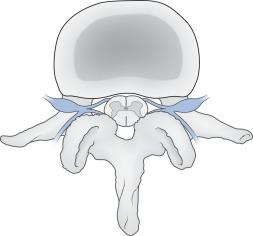
Lumbar stenosis most commonly occurs at the L4–L5 spinal level, followed by the L3–L4 level. Clinical symptoms of lumbar spinal stenosis include the gradual onset of leg and buttock pain combined with lower extremity sensorineural deficits. These symptoms progress over a period of months. The initial diagnostic investigation should include AP, lateral, flexion, and extension plain films. Suggestive findings on plain films include disk space narrowing and erosion and sclerosis of the vertebral end plates. MRI, the imaging modality of choice in lumbar stenosis, typically shows degenerative changes such as facet joint and ligamentous hypertrophy, disk herniation, and nerve root impingement. The initial approach for patients with the symptoms of spinal stenosis is medical management. Surgical therapy is indicated in patients for whom conservative treatment has failed or who have severe and debilitating pain, significant motor deficits, or symptoms of myelopathy.
Spondylolisthesis is a term referring to the anterior displacement of one vertebra on another associated with degenerative changes in the presence of an intact neural arch ( Fig. 21.16 ). Spondylolisthesis may be congenital or acquired. Degenerative spondylolisthesis is a common condition—particularly in individuals older than 50 years—with a reported incidence as high as 8.7%. Women are affected four to six times more commonly than men. The development of spondylolisthesis is associated with the presence of degenerative intervertebral disks, laxity of ligaments, and facet joint pathology.
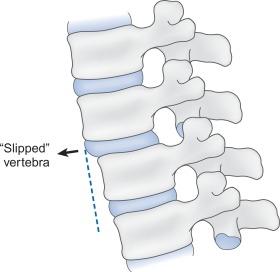
Spondylolisthesis is typically asymptomatic; however, clinical symptoms may develop and are related to the presence of spinal stenosis causing lower back pain, radiculopathy, and neurogenic claudication (lower extremity pain, paresthesias, and weakness associated with walking or standing). The evaluation of patients with spondylolisthesis incorporates clinical symptoms in combination with anatomic abnormalities detected on radiologic imaging studies, because stenosis is commonly present without symptoms. The severity of spondylolisthesis is determined by evaluation of the extent of slip and the slip angle using plain films. The extent of slip is subsequently expressed as a percentage of anterior displacement of the inferior end plate of the vertebral body above with the superior end plate of the vertebral body below. The slip angle is generally less than 30 degrees in patients with degenerative spondylolisthesis, but it may progress in about one-third of patients.
The initiating pathophysiologic event in the development of degenerative spondylolisthesis is deterioration of the intervertebral disk leading to a narrowing of the disk space, which in turn results in buckling of the ligamentum flavum with consequent microinstability of the motion segment. Owing to the loss of normal ligamentous restriction, the vertebra develops an anterior listhesis ( Fig. 21.17 ) or, occasionally, a posterior listhesis.
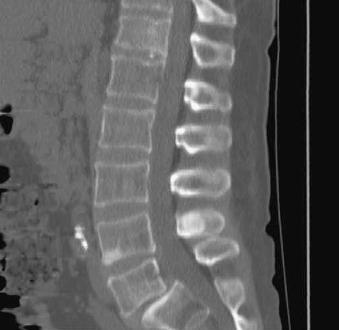
The diagnosis of degenerative spondylolisthesis is based on a combination of plain films and MRI. MRI of the lumbosacral spine is indicated in the presence of neurologic signs and symptoms. MRI detects the presence of ligamentous hypertrophy, spinal cord compression, nerve root impingement, pathologic disk anatomy, and synovial cysts, all of which may be the source of back pain, neurologic deficits, or both.
Definitive therapy in patients with degenerative spondylolisthesis is based on the clinical signs and symptoms combined with the findings from imaging studies. In nearly all cases of lower back pain, with or without neurologic deficits, nonoperative therapy is preferred as the initial treatment for at least the first 4 to 6 weeks. If conservative therapy fails, a trial of epidural steroids and other pain management interventions is appropriate. The indications for surgery include: persistent or recurrent back or leg pain or neurogenic claudication that interferes with the daily activities of life and is unresponsive to 12 weeks of nonsurgical therapy; a progressive neurologic deficit; and symptoms of spinal stenosis. Surgical treatment considerations include the choice of surgical approach (anterior, posterior, or a combination approach) and the specific spine procedure. Surgical decompression with or without lumbar fusion and instrumentation is the usual procedure of choice.
The anesthetic management of patients undergoing operations for lumbar spinal stenosis and degenerative spondylolisthesis must consider the specific surgical procedure and approach planned, the anticipated length of surgery, the anticipated blood loss, whether spinal cord monitoring will be utilized, and any associated comorbidities. Total intravenous anesthesia (TIVA) is often the preferred anesthetic technique, particularly if spinal cord monitoring of motor-evoked potentials is planned. Meticulous attention to patient positioning is important in reducing the incidence of postoperative complications (e.g., nerve injury, blindness).
Spinal infections may involve the vertebral body, the intervertebral disk, the neural arch, or the posterior elements. Vertebral osteomyelitis is the most common of the spinal infections, whereas epidural abscesses are relatively rare. Vertebral osteomyelitis preferentially involves the anterior and middle spinal columns. Although the treatment of vertebral osteomyelitis is usually nonsurgical, surgical intervention may at times be warranted.
Clinically, the symptoms and laboratory findings in patients with vertebral osteomyelitis are nonspecific, with little evidence of a systemic process. The diagnosis relies upon a high index of clinical suspicion in combination with the results of radiologic, microbiologic and pathologic tests. Bacteremic spread is the most likely route of vertebral osteomyelitis and is related to the rich arterial blood supply to the vertebral body, particularly near the longitudinal ligament. Vertebral osteomyelitis most commonly affects the lumbar spine, followed by the thoracic spine, cervical spine, and sacral spine. Patients often complain of localized back pain and paravertebral muscle spasms, with mild neurologic deficits reported in about one-third of patients; other patients demonstrate a severe neurologic deficit or an incomplete spinal cord syndrome. Laboratory tests reveal a leukocytosis in more than half of the patients, an elevation in the erythrocyte sedimentation rate (ESR), and an increase in C-reactive protein (CRP) and procalcitonin levels; , the ESR and CRP are sensitive markers for infection, but nonspecific.
The initial radiologic signs of osteomyelitis are usually absent; after several weeks, radiographic imaging reveals a reduction in disk height and vertebral end plate erosions, followed by the appearance of osteolytic areas, paravertebral soft tissue shadows, and eventual vertebral body collapse. The most sensitive early radiologic imaging technique is a nuclear bone scan using technetium Tc 99m MDP (methylene diphosphonate) with single-photon emission computed tomography. MRI is the gold standard imaging modality for the diagnosis of osteomyelitis, providing accurate detail regarding the intervertebral disk, vertebral marrow, neurologic structures, and paraspinal soft tissue pathology. Typical MRI findings in vertebral osteomyelitis and diskitis include loss of end-plate definition and decreased signal in the disk and adjacent vertebral bodies ( Fig. 21.18 ).
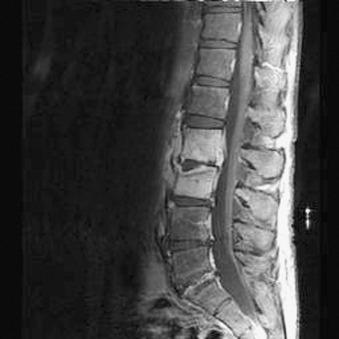
Effective medical therapy begins after making an accurate and rapid diagnosis, followed by 4–6 weeks of a combination of intravenous and oral antibiotic therapy. , , Surgical therapy is required for most cases of vertebral osteomyelitis; the most common indications include: making a definitive identification of the causative organism; progressive neurologic deficits; spinal instability; progressive spinal deformity; and failure of medical therapy.
Epidural abscesses are relatively rare infections, occurring in about 1 in 10,000 hospital admissions. Local spread of bacteria into the epidural space is responsible for about one-third of cases, and bacteremic seeding of the epidural space occurs in about 50% of cases. The clinical manifestations of an epidural abscess include back pain, fever, and neurologic deficits; half of patients with epidural abscesses are initially misdiagnosed at the time of presentation (range, 11–75%). Neurologic deficits are late manifestations of the infection, and when present, require rapid treatment. As in vertebral osteomyelitis, laboratory findings are nonspecific, with a leukocytosis present in two-thirds of patients; however, blood culture results may be positive and patients may appear to be systemically septic. Epidural abscesses are commonly located in the posterior regions of the thoracolumbar spine, and often involve multiple spinal segments.
Spinal epidural abscesses are diagnosed from clinical and radiologic findings in combination with results of culture of drainage material. , Plain radiographs provide diagnostic assistance in less than 20% of the cases, although there may be evidence of coexisting osteomyelitis. MRI with gadolinium enhancement is the radiologic imaging test of choice. This modality can be used to identify the exact location and extension of the epidural infection and to detect spinal cord compression and surrounding edema. Once the diagnosis is confirmed, systemic antibiotic therapy is often combined with surgical drainage. , The most common surgical procedure performed for the treatment of a spinal epidural abscess is a posterior decompressive laminectomy with evacuation of the epidural abscess or phlegmon. Neurologic outcome depends on the patient’s preoperative neurologic condition and the provision of early surgical treatment.
Primary vertebral tumors are uncommon, accounting for less than 5% of spinal tumors; metastatic spinal tumors account for the vast majority of spinal neoplasms. Clinically, the presentation of patients harboring spinal tumors includes pain, progressive spinal deformity, neurologic deficits, or a combination of all three. Radiologic imaging is invaluable in facilitating a diagnosis. For the diagnostic approach to spinal tumors, a simple anatomic classification divides the tumors into extradural, intradural extramedullary, and intramedullary categories ( Box 21.1 ). Surgical biopsy is essential in making a definitive diagnosis; CT-guided fine needle aspirate biopsy is the most common method of diagnosis, with a tissue diagnosis made in 70–80% of biopsies. If the particular tumor type warrants surgical intervention, the specific surgical approach is influenced by the location and size of the tumor, the effect of the tumor on the biomechanical stability of the spine, and the involvement of surrounding tissues. ,
Metastasis
Chordoma
Osteochondroma
Osteoid osteoma
Osteoblastoma
Osteosarcoma
Aneurysmal bone cyst
Chondrosarcoma
Neurofibroma
Vertebral hemangioma
Giant cell tumor
Osteogenic sarcoma
Plasmacytoma
Multiple myeloma
Ewing’s sarcoma
Angiolipoma
Spinal meningioma
Schwannoma
Neurofibroma
Epidermoid/dermoid
Lipoma
Metastasis
Arachnoid cyst
Astrocytoma
Ependymoma
Dermoid/epidermoid
Malignant glioblastoma
Teratoma
Lipoma
Neuroma
Hemangioblastoma
Ganglioglioma
Oligodendroglioma
Paraganglioma
Cholesteatoma
Metastases: melanoma, sarcoma, breast
Extradural spinal tumors account for 50% of all spinal tumors and most commonly originate in the vertebral body or the epidural space. Primary extradural tumors include Ewing’s sarcoma ( Fig. 21.19 ), chordomas, chondrosarcomas, osteoid osteomas, multiple myelomas, and osteosarcomas.
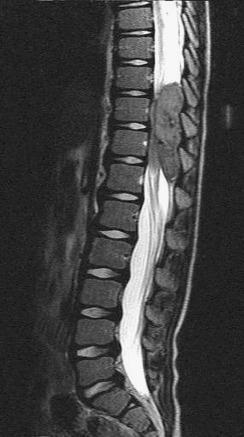
Most extradural tumors are malignant, representing metastatic disease from the lung, breast, prostate, or hematopoietic/lymphoid tissue. Indeed, the skeletal system is a common site of metastatic disease, ranking only behind the lungs and liver in the frequency of occurrence of metastases. As many as 30% of all patients with cancer have metastasis to the spine at autopsy. Spinal metastasis typically involves the vertebral body and occurs through hematogenous seeding or direct extension of a paravertebral tumor. The thoracic spine is the most common location for spinal metastasis, with pain the presenting symptom in most cases. Neurologic deficits may vary from mild radicular symptoms to spinal cord dysfunction. The neurologic deficits may occur in response to pathologic vertebral body fractures or dislocations or to progressive neural compression from tumor growth.
Radiologic imaging is essential for the investigation of suspected extradural spinal metastasis. For highly vascular tumors (giant cell tumors, osteoblastoma, hypernephroma), preoperative angiography with tumor embolization may be used to minimize intraoperative blood loss during resection of a particularly large tumor. The treatment of metastatic disease to the spine involves primarily nonsurgical treatment, particularly in patients without neurologic compromise or spinal instability. These patients are best treated with palliative irradiation, chemotherapy, or both, depending on the tumor cell type. The indications for surgical therapy for extradural spinal disease include the need for tissue diagnosis in the setting of an unknown primary, progressive neurologic deficits, severe pain unresponsive to medical treatment, progressive spinal deformity or instability, radioresistant tumors, and solitary tumors not responding to nonsurgical treatments.
Intradural extramedullary tumors account for 40% of spinal tumors and are located within the dura, but outside the substance of the spinal cord. These tumors may involve the arachnoid tissue, circulating CSF, nerve sheaths, dentate ligaments, filum terminale, and vascular structures. Tumors that arise within this space are typically benign, and more than 90% are either nerve sheath tumors or meningiomas. The nerve sheath tumors can be located at any level of the spine and are usually schwannomas or neurofibromas, which tend to localize in the dorsal or sensory nerve roots. Malignant tumors in this region of the spine are much less common and usually originate from a primary brain tumor (e.g., ependymoma or medulloblastoma) or from meningeal spread secondary to metastatic disease. The thoracic spine is the most likely location for a meningioma (80%), followed by the cervical (10–20%) and lumbar (1–5%) regions.
The clinical presentation of a patient with an intradural extramedullary tumor usually involves the symptoms of myelopathy or radiculopathy. Although CT and MRI are both useful in suggesting the diagnosis, MRI is considered the imaging modality of choice. Surgery is warranted for the treatment of benign intradural extramedullary tumors such as schwannomas, meningiomas, and neurofibromas.
Intramedullary tumors account for 10% of spinal tumors and are located within the substance of the spinal cord. In adults, more than 80% of these tumors consist of astrocytomas and ependymomas. The typical clinical manifestations of intramedullary tumor consist of myelopathy and sensory disturbance below the level of the spinal tumor. When the tumor is located at the level of the conus medullaris, cauda equina syndrome may develop at very late stages. The primary treatment for an intramedullary tumor is surgical laminectomy, followed by tumor resection or biopsy.
Adult scoliosis is defined as any curvature of the spine greater than 10 degrees in the coronal plane in a skeletally mature individual. Adult scoliosis is divided into two groups: idiopathic and “de novo” scoliosis. In the first group, a curve develops during adolescence (idiopathic scoliosis) but is treated only in adulthood. In the second group, the curve first manifests after skeletal maturity (termed “de novo” scoliosis). Degenerative spine disease is the most common cause of de novo scoliosis, although scoliosis may occur after previous spinal surgery or in patients with osteoporosis. Degenerative lumbar scoliosis is a part of the normal aging process that adversely affects the vertebrae, intervertebral disks, spinal ligaments, facet joints, and muscles. This degenerative process leads to wedging of vertebral bodies and disks with progressive spinal rotation and translation, most commonly involving the upper lumbar and lower thoracolumbar spine. Degenerative scoliosis is common, with a prevalence reported to range from 6% to 68% and increases with age, being observed in more than 30% of elderly patients without previous spinal abnormalities. , The initial clinical symptom is typically back pain. Although the incidence of back pain in adults with scoliosis is similar to that found in the general population, the most common indication for eventual surgery is persistent and clinically significant back pain, with 1% of patients undergoing scoliosis surgery.
Thoracic scoliotic curves have a much greater adverse effect on pulmonary function than curves located in other regions of the spine. There is a direct relationship between the magnitude of the curve and the reduction in lung volumes. With thoracic curves greater than 60 degrees, and particularly those greater than 100 degrees, the patient complains of shortness of breath and dyspnea, and spirometric testing shows progressive restrictive pulmonary disease with reductions in vital capacity, forced expiratory volume in 1 second (FEV 1 ), and PaO 2 with all abnormalities being in proportion to the severity of the scoliotic curve.
Most patients with scoliosis-related back pain are effectively treated with nonsurgical therapy. At present, the indications for surgery in the setting of scoliosis include persistent back pain refractory to medical therapy; progressive neurologic deficits; progressive spinal deformity, particularly in the setting of worsening pulmonary function; and postural imbalance related to muscle fatigue. The surgical goals are to correct deformity without creating spinal instability and to allow early patient mobilization. Adult scoliosis surgery is associated with a high complication rate. In studies investigating the incidence of complications following major spine surgery (with most studies including a significant percentage of patients with scoliosis), perioperative complications were noted to occur in over 20% of patients, with reported in-hospital mortality rates of 0.2– 0.5%. Reported complications include infection, acute coronary syndrome, cerebrospinal fluid leak (CSF) leak, failure of the implant, paralytic ileus, deep venous thrombosis, urinary tract infection, and blindness. Risk factors increasing the incidence of postoperative complications include age, pulmonary circulatory disease, heart failure, renal disease, liver disease, coagulopathy neurologic disease, and electrolyte disorders. Pulmonary complications are common, with the highest incidence associated with anterior and anterior/posterior spine operations. Mortality rates are particularly high in patients who develop postoperative pulmonary complications.
An anesthetic plan well suited for major reconstructive spine surgery includes the use of a balanced general anesthetic technique, invasive hemodynamic monitoring, and large-bore intravenous catheters. The use of a TIVA technique may be indicated if neurophysiologic monitoring is planned.
Rheumatoid arthritis (RA) is the most common of the inflammatory diseases, affecting approximately 1% of the world’s population. RA is characterized by a chronic, systemic, autoimmune inflammatory state resulting in symmetrical pain, heat, swelling, and destruction in synovial joints of the hands and feet, wrists, elbows, hips, knees, ankles, and the cervical spine. The T cell-mediated inflammatory state of RA affects synovial tissues throughout the body, resulting in hypertrophy of joint tissue and erosion of articular cartilage and subchondral bone. The cervical spine is often affected, with involvement of the synovial joints of the cervical spine, particularly those surrounding the C1–C2 articulation. The synovitis weakens the surrounding supportive structures, resulting in axial instability that may lead to subluxation of the C1–C2 articulation and spinal cord compression. Atlantoaxial subluxation affects as many as one-fourth of patients with RA and is the most common cervical spine manifestation of RA.
Clinically, patients with RA involving the cervical spine may complain of cervical neck pain, headaches, and limitation of neck movement. In severe disease, subaxial subluxation may cause progressive cervical myelopathy with spasticity of the legs, motor weakness, and incontinence, or symptoms of nerve root compression. The diagnosis of cervical spine involvement in RA relies upon typical radiologic findings, including atlantoaxial subluxation, narrowed disk spaces, erosion of vertebral end plates, apophyseal joint erosion with blurred facets, and spinal osteoporosis. A CT scan is of value for detecting the extent of cervical spine bony destruction, whereas MRI is useful for identification of spinal cord pathology and soft tissue abnormalities.
Surgery is indicated in the presence of myelopathy; severe neck pain with a neurologic deficit; and excessive subluxation of C1–C2 with spinal canal stenosis, vertebral artery compromise, and spinal cord compression. Patients demonstrating symptoms of myelopathy, particularly in the presence of C1–C2 subluxation, require urgent posterior spinal decompression and instrumented fusion; current options may include C1 lateral mass screws in conjunction with C2 pedicle, pars or translaminar screws or C1–C2 transfacet screws and bone grafting. The presence of subaxial subluxation (C3–C7) warrants realignment and stabilization from a posterior approach, particularly when multiple levels are involved. An anterior approach may be appropriate as an alternative technique, especially in the case of significant kyphotic deformity. In select cases, a combined anterior and posterior approach may need to be utilized.
The anesthetic approach for a patient undergoing surgery for RA should take into account the airway concerns unique to these patients, including limitation of neck and temporomandibular joint movement (limiting visualization of the larynx), arthritic involvement of the cricoarytenoid joints (preoperative hoarseness and stridor) with a narrowed tracheal inlet, atlantoaxial subluxation with potential vertebral artery compromise, basilar impression (from rostral advancement of the odontoid process with compression of the spinal cord or medulla), and instability of the lower cervical spine. Accordingly, an awake fiberoptic intubation or video-assisted laryngoscopy may be considered to minimize further neurologic injury during the induction of anesthesia and positioning of the patient.
Ankylosing spondylitis (AS) is considered the prototypical seronegative spondyloarthropathy; it is characterized by a progressive inflammatory involvement of the spine and axial skeletal joints, which may result in severe spinal deformity ( Fig. 21.20 ). The disease is three times more common in men than in women. In addition to axial skeletal disease, AS involves enthesopathy (inflammation at the sites of tendon and ligamentous insertions), the presence of human leukocyte antigen (HLA-B27), and the absence of rheumatoid nodules and rheumatoid factor in serum (seronegative). The regions of the spine most often involved in AS are the sacroiliac, costovertebral, zygapophyseal, and discovertebral joints. Ankylosing spondylitis-associated fractures are most commonly seen in the lower cervical spine (C6–C7), although they may also occur in the lumbar and thoracic segments. Diseases associated with AS include peripheral polyarthritis, C1–C2 subluxation, valvular heart disease, aortitis, restrictive pulmonary disease, upper lobe pulmonary fibrosis, colitis, renal amyloidosis, osteoporosis, psoriasis, uveitis, and iritis.
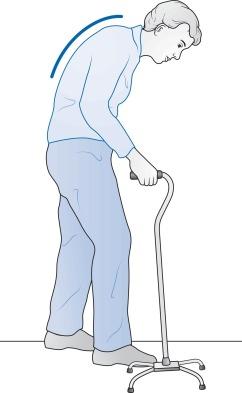
Surgery is indicated for individuals with severe spinal deformities that adversely affect normal activities and in patients who have spinal instability due to spondylodiskitis or spinal fracture. In patients with AS who are scheduled for corrective spine surgery or for unrelated surgical procedures, careful preoperative assessment is essential. A thorough history should focus on the patient’s habits, lifestyle, and medications (e.g., use of opioids, nonsteroidal anti-inflammatory agents). Areas of particular focus should include: kidney, pulmonary, gastrointestinal, and nutritional assessment. In addition cervical spine flexibility and airway anatomy must be carefully evaluated in AS patients, as the potential for a difficult airway is increased. The presence and severity of cervical kyphosis should be noted as patients with marked neck flexion may mandate a fiberoptic airway approach or other advanced airway technique.
Osteoporosis is a metabolic bone disease characterized by a decrease in bone mineral density and disrupted microarchitecture that leads to a higher risk of fractures, particularly of the hip, spine, and wrists. The prevalence of primary osteoporosis affects approximately 10 million individuals in the United States, making it the most prevalent bone disease. It is found most commonly in women after menopause (up to 30% are affected), but may occur in men and premenopausal women in the presence of hormonal disorders or other chronic disease states, in which case it is termed secondary osteoporosis. Disease states associated with secondary osteoporosis include hyperthyroidism, gastrointestinal disorders, disorders of calcium balance, and chronic steroid use.
Fractures are common in osteoporosis. Vertebral compression fractures, one of the most frequent complications of osteoporosis, occur most often in the thoracic and lumbar spine. In fact, the incidence of vertebral fractures has been estimated to occur in up to 25% of women at 50 years of age. Development of an acute fracture manifests as acute pain localized over the affected area or referred across the chest. After the fracture heals, the patient may complain of chronic back pain. In the thoracic spine, osteoporotic fractures are located primarily in the anterior aspect of the vertebral body, causing a compression fracture that appears as a wedge shape on plain films. The wedge-shaped vertebral body results in a dorsal kyphosis, particularly if fractures affect multiple spinal levels. In the lumbar spine, the vertebral fractures are located more evenly throughout the vertebral body, resulting in a compression fracture without the wedge shape.
The diagnosis of osteoporosis relies on a combination of clinical history, plain radiographs, bone mineral density (BMD) testing, and biochemical markers suggesting rapid bone turnover (bone-specific alkaline phosphatase). Osteoporosis is treated nonsurgically in the majority of cases. Surgical intervention is indicated in the setting of acute vertebral compression fractures associated with severe pain unresponsive to medical therapy, neurologic deficits, and in the presence of progressive spinal deformity and instability. The goals of surgical treatment for osteoporotic fractures include early mobilization and functional return to daily activities of life. The procedures most commonly performed for osteoporotic vertebral compression fractures include minimally invasive vertebroplasty and balloon kyphoplasty. Although the clinical efficacy of these procedures has been questioned, , recent reports support the general consensus that vertebroplasty and kyphoplasty are safe, efficacious, and durable procedures for the treatment of appropriate patients with pathologic fractures due to osteoporosis and neoplastic processes.
Among individuals suffering general traumatic injuries, the cervical spine is involved in 4.3% of cases, the thoracolumbar spine in 6.3% of cases, and the spinal cord in 1.3%. , The most common causes of spine trauma are motor vehicle accidents, falls, violence, and sports-related injuries (in that order). Spinal injuries have a predilection for the more mobile areas of the spine, which include the cervical spine (75% of cervical spine injuries are at C3–C7) and the thoracolumbar junction (16% of thoracolumbar injuries are at the L1 junction), with as many as one-fifth of injuries to the spine occurring at multiple levels.
In general, the goals of management following spinal trauma are: prevention of further neurologic injury; enhancement of neurologic recovery if deficits exist; neurologic decompression; and the surgical correction of spinal malalignment or deformity. The initial evaluation and resuscitation of the trauma patient includes a detailed neurologic examination performed to detect the presence of neurologic deficits (see Fig. 21.25 ) combined with radiologic imaging of the spine; these actions complete the spine trauma assessment.
An understanding of the biomechanics of spinal impact and resulting spinal injury is helpful in estimating the probability and severity of both the spinal column and SCI as well as the planning of effective therapy. Traumatic spinal injuries most commonly occur after impact forces that result in the following seven basic types of spinal trauma: hyperflexion, hyperextension, compression, rotation, shear, avulsion injuries, and a combination of these types. A mechanistic classification of cervical spinal injuries based on the original classification proposed by Allen and colleagues , is illustrated in Fig. 21.21 . A summary table of selected traumatic spinal injuries, associated neurologic sequelae, and the common treatments are provided for reference ( Table 21.1 ).
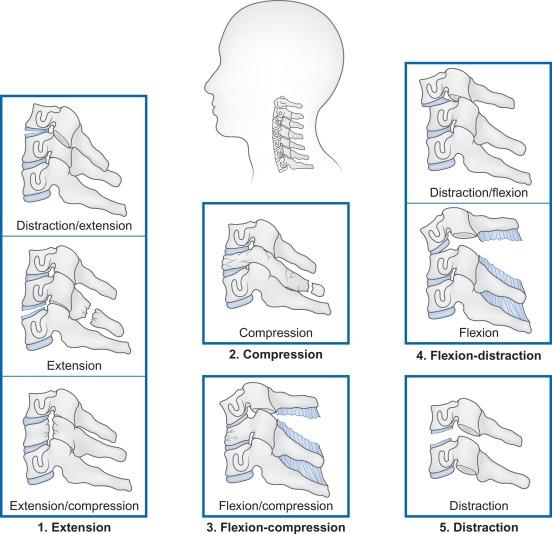
| Spinal Injury | Typical Clinical Findings | Treatment |
|---|---|---|
| Upper Cervical (C1–C2) Spine Injuries | ||
| Atlanto-occipital dislocation | Unstable; commonly fatal; if patient survives there are neurologic deficits | Immediate halo vest vs. hard collar, then posterior occipitocervical fusion |
| Atlas burst fracture (Jefferson fracture) | Usually stable and neurologically intact; associated with head injuries and other cervical spine fractures | Cervical orthosis if nondisplaced; halo vest for 3 months vs. surgery if displaced; posterior C1–C2 fusion if instability persists after immobilization |
| Atlantoaxial dislocation/subluxation | Usually neurologically intact | Reduction and immobilization vs. posterior fusion |
| Isolated odontoid fracture: tip of dens (type I); base of the dens (type II); extension into the C2 body (type III) | Type I, stable; type II and III, usually unstable, with neurological deficits in 14% of type II and 8% type III | Type I, rigid cervical collar; type II and III, cervical immobilization, ± surgical posterior C1–C2 fusion |
| Axis fracture (hangman’s fracture)—bilateral pars interarticularis (type I); bipedicular fracture (type II); severe displacement, uni- or bilateral facet dislocations (type III) | Usually neurologically intact (type I and II); type III very unstable, neurologic injuries | Type I, rigid cervical collar; type II, initial traction then halo vest vs. surgery; type III, open reduction and fusion |
| Subaxial Cervical (C3–C7) Spine Injuries | ||
|---|---|---|
| Axial Compression | ||
| Wedge compression fracture | May be stable; neurologically variable | Depends on severity of fracture: cervical collar or halo vest for stable fractures; if disruption of posterior longitudinal ligament, surgical stabilization-fusion |
| Burst fracture | Stability is variable, depending on ± involvement of the posterior ligamentous complex (PLC); neurologically variable | Cervical immobilization vs. surgical stabilization-fusion |
| Flexion–Compression | ||
| Teardrop fracture | Usually unstable; neurologically variable | Immobilization vs. surgical stabilization-fusion |
| Flexion–distraction | Stability is variable, depending on ± posterior ligamentous injury; neurologically variable | Immobilization; ± surgical stabilization-fusion |
| Extension–Distraction | ||
| Hyperextension, ± fracture ± dislocation: | Stability is variable, depending on ± posterior ligamentous injury; neurologically variable; seen in elderly patients with spinal stenosis; (central cord syndrome) | Immobilization; ± surgical decompression-fusion |
| With retrolisthesis | Unstable, neurologically variable | Surgical stabilization |
| Rotation–Flexion or Extension | ||
| Isolated facet fracture without dislocation | Stable; usually neurologically intact | Cervical collar |
| Unilateral facet dislocation ± fracture | Often unstable; neurologically variable | Open or closed reduction; ± surgical stabilization and fusion |
| Bilateral facet dislocation ± fracture | Very unstable; disrupted posterior stabilizing elements; usually severe neurologic deficits | Open or closed reduction; surgical stabilization and fusion |
| Thoracolumbar Injuries | ||
|---|---|---|
| Transverse process, spinous process, and articular process fractures | Stable; neurologically intact | Symptomatic; ± orthoses |
| Compression Fractures | ||
| Wedge fracture | Usually stable and neurologically intact; unstable if severe compression (> 50% loss of vertebral body height, > 30° kyphosis deformity) | No orthosis vs. thoracolumbosacral orthosis (TLSO) if stable; surgical stabilization if unstable |
| Burst fracture | Stable if minimal posterior column disruption; unstable if neurologic deficits and/or posterior column disruption; neurologically variable | TLSO if stable and neurologically intact; surgical stabilization-fusion if unstable and/or neurologic deficits |
| Flexion–Distraction | ||
| Chance fracture (horizontal fracture through anterior-posterior bony elements) | Usually unstable; neurologic deficits in 10% to 15% | Surgical stabilization-fusion (rarely TLSO brace) |
| Fracture–dislocation | Highy unstable; neurologic deficits ≥ 75% | Early surgical reduction, stabilization-fusion |
| Extension–distraction | Rare (patients with metabolic bone disease); unstable; neurologic deficits common (≥ 75%) | Surgical stabilization-fusion |
| Penetrating missile injury | Neurologically variable; recovery poor | Symptomatic treatment; spinal orthoses if 2 to 3 spinal column involvement |
Hyperextension injuries are most common in the cervical region and are a common cause of lower cervical neck injuries ( Fig. 21.22 ). Hyperextension injuries may result from facial or frontal trauma, whereby the forces separate the vertebral body and the adjacent lower end of the intervertebral disk. Hyperextension injuries result in disruption of the anterior and middle spinal columns in tension, reducing the AP diameter of the spinal canal and compressing the spinal cord between the posterior aspect of the vertebral body and the ligamentum flavum and lamina. Elderly individuals with cervical spondylosis are particularly susceptible to hyperextension injuries, and even moderate hyperextension may produce cord injury. The vertebral arteries may be damaged in cervical extension injuries, particularly in people with severe spondylosis. Hyperextension injuries are typically unstable owing to the disruption of the stabilizing ligamentous elements and injury to the intervertebral disks.
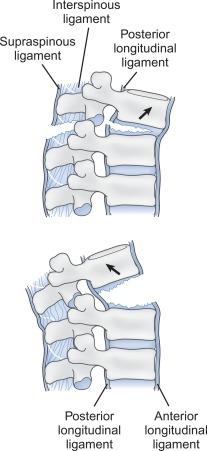
Compression injuries occur after impact forces containing a significant axial load (e.g., falls on the occiput) and result in wedge compression fractures, burst fractures ( Fig. 21.23 ), and ligamentous rupture. Wedge compression fractures, most common in the thoracolumbar region, result from pure flexion injury, whereby the posterior ligamentous complex remains intact. Compression injuries with burst fractures often cause serious neurologic damage from retropulsion of bone fragments, ligaments, and disk material into the spinal canal. Compression injuries associated with flexion may produce the so-called teardrop fracture, in which the vertebra is dislocated anteriorly, with an associated avulsion of the superior aspect of the vertebra and posterior longitudinal ligament damage, usually with significant neurologic damage.
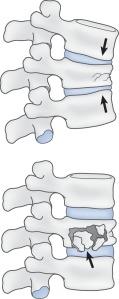
Hyperflexion injuries may be divided into flexion–compression and flexion–distraction injuries. The direction of the applied load determines the particular injury pattern. Simple flexion–compression fractures results in wedge fractures of the vertebral body that cause a loss of anterior vertebral body height, creating a wedge shape. These injuries are typically stable, unless significant loss of vertebral body height results. Severe flexion–distraction injuries occur from a combination of flexion and distraction loads, with the center of rotation located anteriorly. This injury results in characteristic subluxations or dislocations (see Fig. 21.22 ) of the vertebral bodies with disruption of the posterior longitudinal ligament, causing significant spinal instability. Herniation of the intervertebral disks is commonly seen after severe flexion injuries, as is dislocation of the facet joints, particularly if enough of a rotational component is involved.
Flexion and extension injuries that include significant rotational forces may result in severe spinal injuries, including subluxation, dislocation, and fracture–dislocations. Serious injuries to the vertebral bodies and intervertebral disks are often involved in the process ( Fig. 21.24 ).
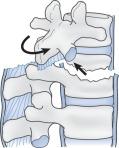
Rotational spinal injuries often result in severe injuries to the spinal cord and cauda equina. In particular, hyperflexion–rotation forces associated with dislocation may produce either unilateral or bilateral locked facets. Bilateral facet dislocations (locked facets) are associated with major neurologic injury and often require surgical reduction and stabilization. These are most often seen in the lower cervical spine (C5–C7). Fractures of the vertebral peduncles may be associated with bilateral facet dislocations. Unilateral facet dislocations may be associated with no neurologic injury; however, they may be associated with nerve root compression or an incomplete SCI.
Some degree of spinal translation is involved in most spinal injuries, including spinal fractures and ligamentous tears. The shear mechanism typically involves all three columns of the spine and is associated with a higher incidence of facet dislocation.
Avulsion injuries are typically stable injuries. Examples of avulsion injuries include the odontoid type 1 fracture, in which the tip of the odontoid process is fractured or chipped, and the hyperextension teardrop fracture.
Combined injuries, resulting from various vectors of force such as axial loading, rotation, and flexion or extension, chiefly affect the cervical region and commonly produce ligamentous tears and distraction (an increase in distance between individual components of adjacent vertebrae. For example, a combined injury, or whiplash, involves rapid acceleration–deceleration forces resulting in extreme extension followed by flexion and is often associated with rotation, compression, and tearing forces. This kind of acceleration lesion distorts the spinal components, damaging the soft tissues of the neck, muscles, and anteroposterior ligaments, and sometimes involves nerve roots and disks.
Traumatic spondylolisthesis of the axis occurs with motor vehicle accidents when the driver’s face or chin hits the steering wheel. The extreme hyperextension of the neck produces shear stresses on the C2–C3 vertebral units, resulting in fracture of the neural arches with dislocation between C2 and C3. However, the avulsed arches decompress the cervicomedullary junction, so patients seldom experience neurologic deficits and usually have a good prognosis.
Mid-thoracic to upper thoracic spinal injuries are much less common than injuries of the cervical or thoracolumbar regions, because of the protection and fixation of the thoracic area by the rib cage and sternum. The greater mobility of the vertebral column at the thoracolumbar junction contributes significantly to the frequency of spinal injuries in this region. Injury to the thoracolumbar spinal column can result in wedge fractures of the vertebrae, with destruction of the laminae, pedicles, and facets. Protrusion of the vertebral body or disk material into the spinal cord may occur. The addition of torque results in fracture–dislocations of the vertebral column. Lumbar fractures have been reported to occur much less often and are the result of flexion and compression forces. Neurologic injuries that involve only the cauda equina have a high potential for significant neurologic recovery.
Penetrating wounds of the spine may cause significant damage, including direct and indirect spinal cord injury through transmitted energy. Many of these injuries produce damage to both the spinal cord and nerve roots as a result of associated shear stress; compression and contusion of cord tissue by bony impingement, herniated disks, or intraparenchymal bone fragments; or ischemia caused by interruption of the vascular supply. However, no consistent relationship exists between actual trauma to supporting structures and injury to the spinal cord. Thus, a patient may present with a stable spine without bony or ligamentous injury and still sustain SCI or may have serious fractures and an unstable spine without neurologic deficits. In adults, the areas most susceptible to injury are the lower cervical spine (C5–C7) and the thoracolumbar junction (T12– L1), regions of the spine coinciding with the areas of greatest spinal column mobility.
In patients with spinal trauma, a neurologic examination is essential in establishing a baseline of neurologic function and in facilitating the decision matrix for specific radiologic testing. Following the primary trauma survey, the neurologic evaluation process includes an assessment of mental status, an examination of the spinal column, and an evaluation of the sensorimotor function of the extremities. Initially, the clinician palpates the spine in its entirety, specifically noting tenderness, evidence of hematoma, or spinal misalignment. During examination of the patient, it is important to maintain spinal precautions at all times (i.e., log rolling, maintaining neutral neck position). The neurologic examination should be accurately detailed in the medical record using the American Spinal Injury Association (ASIA) International Standards for Neurological Classification of Spinal Cord Injury (ISNCSCI) examination worksheet ( Fig. 21.25 ).
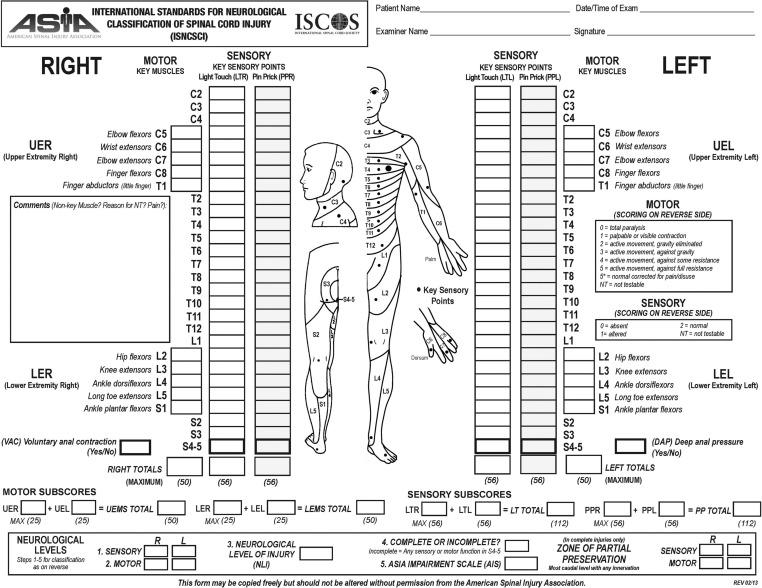
The ASIA worksheet standardizes the neurologic evaluation process and facilitates the accuracy of the neurologic examination (see Fig. 21.25 ). In the ASIA system, the neurologic assessment includes the testing of key muscle groups and sensory points. For muscle testing, 10 groups are tested corresponding to 10-paired myotomes. The function of these muscles is graded on a 6-point scale, with 0 assigned for total paralysis and 5 points assigned for normal strength. In total, there are 100 points when the right and left sides are assessed.
The second part of the ASIA neurologic examination is the sensory score, which is based on the evaluation of 28 sensory dermatomes on the right and left sides of the body. At each of these key points, both the sensation to pinprick and light touch are tested and scored on a scale of 0 to 2 (0, absence of sensation; 1, impaired sensation; and 2, normal sensation). In addition to the testing of key muscles and sensory points, voluntary motor contraction of the external anal sphincter is tested by digital examination. Perirectal sensation is also tested; this sensation, along with the presence of the bulbocavernosus reflex or the anal-cutaneous reflex, is an important signal of the preservation of distal function (sacral sparing), indicating incomplete SCI and predicting a more favorable prognosis. The testing of proprioception (position sensation) is considered optional but is highly recommended.
Finally, an assessment should be made of the completeness of the neurologic injury as defined by the ASIA Impairment Scale ( Table 21.2 ). In this scale (formerly called the Frankel scale), the neurologic injury is divided into one of five possible grades. The term sensory level or motor level is used to define the most caudal segment of the cord with normal sensory or motor function, respectively, on both sides of the body.
| ASIA Grade | Type of Injury | Definition of Type of Injury |
|---|---|---|
| A | Complete | No motor or sensory function |
| B | Incomplete | Sensory but not motor function is preserved below the level of the injury |
| C | Incomplete | Motor function is preserved, but majority of key muscles below the neurologic level have a muscle grade < 3 |
| D | Incomplete | Motor function is preserved, and majority of key muscles below the neurologic level have a muscle grade ≥ 3 |
| E | Normal | Motor function and sensory function are normal |
The diagnosis of SCI should be considered when the following signs or symptoms are present: motor signs, such as weakness or paralysis of the extremities or trunk muscles; sensory signs, such as the absence or alteration of sensation of the trunk or extremities; bowel or bladder incontinence; abrasions, lacerations, or deformities of the spine, neck, or head region; and tenderness or pain on palpation of the spine or neck. The patient’s neck or back should not be moved to determine whether it is painful but should only be palpated. An unconscious patient must be considered to have an SCI until proved otherwise. An injury to other systems (e.g., head injury) may mask an SCI; conversely, an SCI may mask other system injuries (e.g., visceral rupture or fracture of long bones).
The goal of imaging after spinal trauma is to recognize and quantify spinal injury as well as to aid in determining prognosis ( Table 21.3 ). The mechanism of injury combined with the clinical examination and the hemodynamic stability of the patient will guide the initial choices for spinal imaging. The results of radiologic tests and identification of neurologic deficits define the final pathologic state. For patients without clinical evidence of spinal cord injury, radiologic imaging of the cervical spine may not be necessary. In particular, the NEXUS decision tool or the Canadian Cervical Spine rule can be utilized to identify those individuals for whom spinal imaging is unnecessary. , The American Association of Neurological Surgeons (AANS) and the Congress of Neurological Surgeons (CNS) recently published updated guidelines for the management of acute cervical spine and spinal cord injuries. The guidelines state that for the awake, asymptomatic patient who is without neck pain or tenderness, has a normal neurological examination, is without an injury detracting from an accurate evaluation, and is able to complete a functional range of motion examination, radiographic evaluation of the cervical spine is not recommended. , For trauma patients considered to have, or be at risk for, cervical spine injuries, a CT scan is now considered the initial radiologic modality of choice. Plain films of the cervical spine are regarded as a second line imaging choice, to be used if CT is unavailable.
| Category | Plain Radiograph | Computed Tomography | Magnetic Resonance Imaging |
|---|---|---|---|
| Bony anatomy | ++ | +++ | ++ |
| Ligament injury | + | + | +++ |
| Spinal canal size | 0 | +++ | +++ |
| Spinal cord compression | 0 | ++ | +++ |
| Nerve root compression | 0 | ++ | +++ |
| Hemorrhage and edema | 0 | + | +++ |
| Syrinx formation | 0 | ++ | +++ |
| Prediction of deficit | ++ | ++ | +++ |
| Prediction of outcome | + | ++ | +++ |
Become a Clinical Tree membership for Full access and enjoy Unlimited articles
If you are a member. Log in here